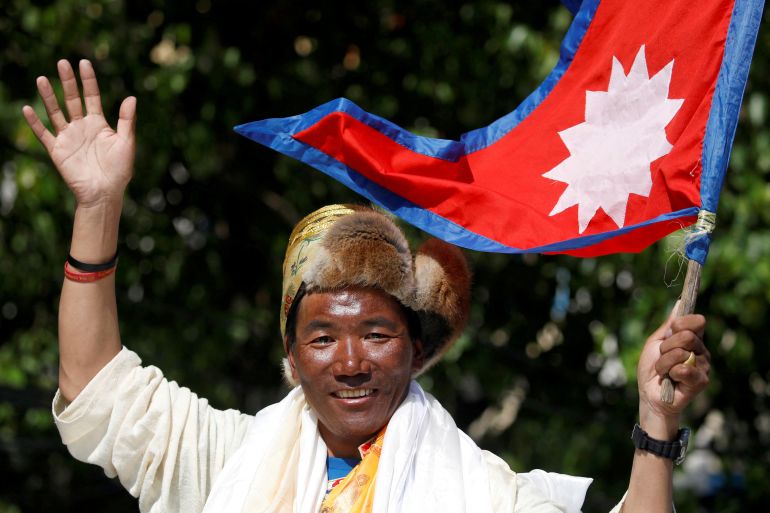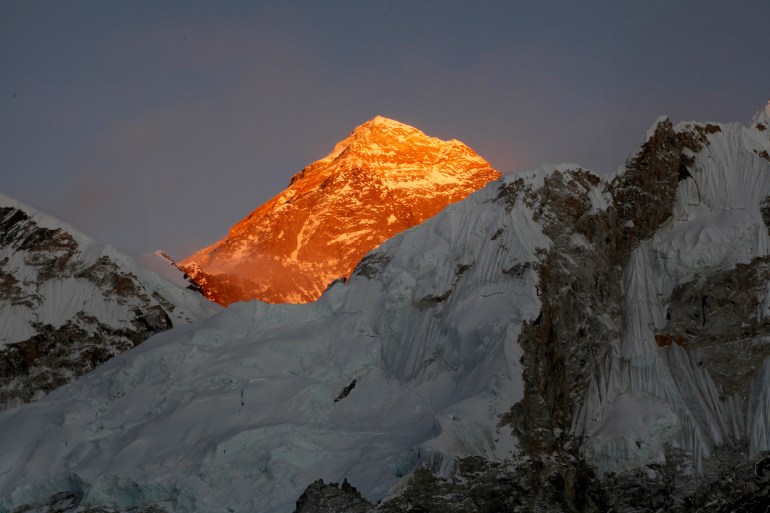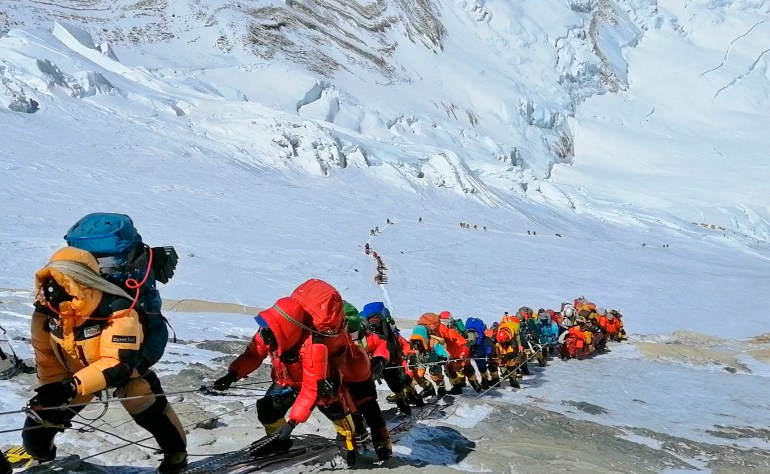‘Everest Man’: Nepalese Sherpa climbs summit for record 27th time
Kami Rita reclaims his record after another Nepalese Sherpa tied it by reaching the Himalayan peak for the 26th time on Sunday.

Nepalese climber Kami Rita Sherpa has reached the top of Mount Everest for the 27th time, reclaiming the record for the most summits of the world’s highest mountain, a government official and his hiking company said.
Kami Rita, 53, scaled the 8,849-metre (29,032-foot) mountain early in the morning on Wednesday, along the traditional southeast ridge route, guiding a Vietnamese climber.
Keep reading
list of 4 itemsNepal issues record 454 Mount Everest climbing permits
Nepal says tourists trekking in Himalayas must hire local guides
Coping with climate change on Mt Everest
“Yes, Kami Rita climbed Sagarmatha for the 27th time,” said Department of Tourism official Bigyan Koirala, referring to the mountain by its Nepali name.
Thaneswar Guragai, manager of the Seven Summit Treks, for which Kami Rita works, said he arrived at the summit at 8:30am (02:45 GMT) along with the foreign climber.
“We are trying to get details. For now it is 100 percent confirmed that Kami Rita scaled for the 27th time,” Guragai said.
Nepal is home to eight of the world’s 10 highest peaks, including Everest, and welcomes hundreds of adventurers each spring, when temperatures are warm and winds are typically calm.
Earlier on Wednesday, British mountain guide Kenton Cool reached the world’s highest point for the 17th time, extending his own record for the most summits by a non-Nepalese.
Authorities have issued 478 permits to foreign climbers this year, the $11,000 fee part of total costs for a summit ranging from $45,000 to $200,000.
Since most will need a guide, more than 900 people – a record – will try to reach the summit this season, which runs until early June.
Kami Rita had held the overall title since 2018, when he ascended Everest for the 22nd time, passing the previous mark he shared with two other Sherpa climbers, both of whom have since retired.
He scaled Everest for the first time in 1994 and has climbed it almost every year since then, except in 2014, 2015 and 2020, when climbing was halted for various reasons.
But on Sunday, another climber, Pasang Dawa Sherpa, 46, tied the record by reaching the top for the 26th time.

‘Everest Man’
Dubbed the “Everest Man”, Sherpa was born in 1970 in Thame, a village in the Himalayas renowned as a breeding ground for successful mountaineers.
Growing up, Sherpa watched his father and then his brother don climbing gear to join expeditions as mountain guides, and was soon following in their footsteps.
A guide for more than two decades, Kami Rita first summited in 1994 when working for a commercial expedition.
Since then, he has climbed Everest almost every year, several times leading the first rope-fixing team to open the route to the top.
“These records were made not with an intention to make them but during my work as a guide,” Sherpa told AFP News Agency last month as he headed to Base Camp.
In 2019, he reached the summit twice within six days.
Sherpa’s client on Wednesday was reportedly Chinh Chu, a Vietnamese billionaire who made his fortune in finance, while Cool guided Richard Walker, executive chairman of British supermarket chain Iceland Foods, to the top.

Too many climbers
Sherpas’ mountaineering expertise and local knowledge are critical to the safe passage of the hundreds of climbers who ascend Everest every year.
Nepalese guides, usually ethnic Sherpas from the valleys around Everest, are considered the backbone of the climbing industry and bear huge risks to carry equipment and food, fix ropes and repair ladders.
Cool, 49, first climbed Everest in 2004 and his 16th ascent last year gave him the sole record for the most summits by a non-Nepalese climber, but said then that he was “surprised” by the attention.
“In reality, it’s not that amazing,” he said, pointing out that many Sherpa guides had stood on the peak more often than him.
“People go ‘it’s a world record’, it’s not a world record,” he said. “It’s just that I happen to hold the non-Sherpa record, for whatever that is worth, which in my mind, [is] not very much.”
Three Nepali climbers died on the mountain last month when a block of glacial ice fell and swept them into a deep crevasse as they were crossing the treacherous Khumbu Icefall as part of a supply mission.
The number of deaths increased to four when a 69-year-old US mountaineer died this month during his acclimatisation rotation at about 6,400 metres.
The Himalayan nation, which is heavily reliant on climbing, trekking and tourism for foreign exchange, has been criticised for allowing too many climbers, many of them inexperienced, to try for Everest’s summit.
Climbing contributed $5.8m to state coffers this year, $5m of it from Mount Everest, according to government data.
Dangerous overcrowding can develop, especially at a bottleneck called the Hillary Step, just below the summit. In 2019, nine exhausted climbers died near the summit after queues built up of climbers going up and down.
Everest has been climbed more than 11,000 times, from both the Nepalese and Tibetan sides, since it was first scaled in 1953, with many people ascending it multiple times.
More than 320 people have died on the mountain, hiking officials said.